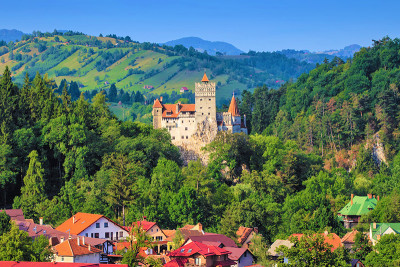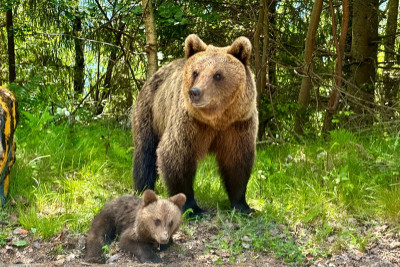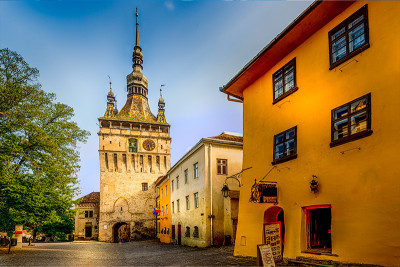If you are unfamiliar with Romanian culture and you are traveling to Romania for the first time, you might come across some traditions that you seem really strange to you. Honestly, these traditions are not strange, but are simply unique to Romania. Ask any Romanian about these traditions and they will probably nod with a smile, thinking upon all the times that they or their loved ones have participated in these traditions themselves.
Or, if you are traveling to Romania for the first time, read about these traditions and impress the locals with how much you already know about Romanian culture! Whatever your motive for learning about Romanian culture, read on to be shocked, surprised and enlightened by the beautiful Romanian customs and traditions.
1. Boboteaza
If you are a single woman and you want that to change, have no fear, there is a special holiday for you! On January 6th, single women all over Romania put a couple leaves of basil under their pillow and they dream about their prince charming. Tradition says that putting basil under your pillow on this day will help you meet the love of your life! January 6th is the Day of the Epiphany, also called Boboteaza or Teofania.
In Western Christianity, this is known as the Epiphany. In Eastern Christianity, this celebrates something different: the day that Jesus was baptized in the Jordan River by John the Baptist. Really, the celebration begins the day before as the priests bless the waters to hand out at church the following day. Parishioners take a small bottle of water home and use it to bless their homes, possessions, and animals. People also drink the water every morning for the proceeding nine days.
2. The Ice Swim
Alright, January 6th has a lot going on – on this day, men who are courageous enough celebrate the baptism of Jesus by diving into their local rivers and lakes in search of a wooden cross. The local priests place the cross somewhere in the waters, and the men have to search for it and bring it to shore. Those men who are able to find it and bring it back to land are to have great luck for the following year.
3. Dragobete
On February 24th is Dragobete is celebrated. Dragobete is the traditional Romanian love holiday, while Valentine’s Day is much newer (but also celebrated by some in Romania). Dragobete is known as “the day when the birds are betrothed” because it is around this time that the birds begin to gather twigs for their nests and start to mate.
In the countryside, boys and girls will go into the woods to pick flowers and when they come back, if the boy likes the girl, he will try to kiss her. There is a Romanian saying that is “Dragobete kisses the girls.” One of the superstitions about Dragobete is that a single woman must touch a man, otherwise they will have bad luck with love until next year.
4. Mucenici
Mucenici is a light dessert made out of dough that is shaped into the number eight. It is prepared every March 9th, in commemoration of the Forty Martyrs of Sebaste. This is a Christian holiday, remembering the 40 Roman soldiers who died in 320 A.D. by Licinius, who was Roman emperor from 308-324 A.D. He killed these 40 Roman soldiers because they refused to give up their Christian faith. Mucenici is in the shape of an eight because it is believed that the soldiers were in prison for eight days.
5. Babele
The beginning of spring in Romania, like in many other places, is quite unpredictable. It can go from practically freezing one day to sunny and beautiful the next. That is why this tradition came about. Right before March, you have to choose one day from March 1st to March 9th.
You are not allowed to look at the weather forecast, but the goal is to choose a day with nice weather. If the weather turns out nice on the day you chose, that means you will have a good year! If the weather isn’t great, that means your year will not be as good.
6. Cucii
Cucii means “the Cuckoos” in English This is a tradition that takes place in certain villages in Branesti and Calarasi. It takes place right before Lent, and the entire village gets excited for the event. The Cuckoo is the main character, who has to wear a mask that looks like a globe, complete with plenty of paper flowers and ribbons. The men dress as women, wearing their lover’s clothes.
These men wear loud bells and a stick, and they gently touch the audience around them so that they can protect themselves from disease in the year to come.
7. Sanzienele
If you have heard of the Swedish Midsummer holiday, then this one might sound familiar to you. Sanzienele is a holiday celebrated on June 24th to commemorate the summer solstice. Sanzienele are good fairies in Romanian folklore and this is a holiday to celebrate these fairies.
Young women dress in long, white folk-style gowns and wear crowns made out of wild flowers. They normally gather in the evening and dance around a bonfire. Tradition says that the skies open up that night and magical things can occur.
And if you have not yet met your love after Boboteaza, you have another chance on this night to give yourself good luck for the year to come – unmarried women have to dream about their future lover at night and put a couple Lady bedstraw flowers under their pillows. Other traditions say that a woman has to throw an entire bucket of sanziene flowers from her rooftop to have enough luck to find her husband!

 ES
ES
 IT
IT
 DE
DE
 FR
FR


